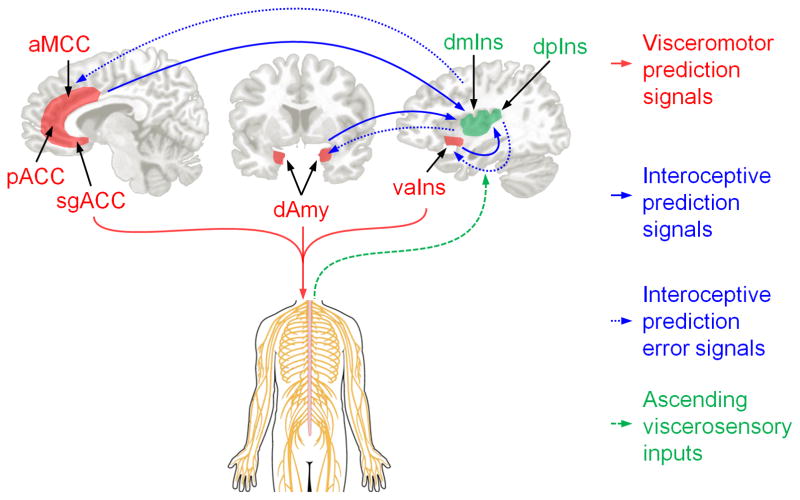Fig 1.
We identified key visceromotor cortical regions (in red) that provide cortical control the body’s internal milieu, including the anterior mid cingulate cortex (aMCC; also called dorsal anterior cingulate cortex (dACC), e.g., 41,42), pregenual anterior cingulate cortex (pACC), subgenual anterior cingulate cortex (sgACC; for a review of the cingulate, see 176), and the ventral anterior insula (vaIns; also called agranular insula43,183 or posterior orbitofrontal cortex194); these regions have a less-developed laminar structure (i.e., they are agranular or dysgranular32,176). We also included the dorsal amygdala because it contains the central nucleus which is also involved in visceromotor control (for a review, see 153). Primary interoceptive cortex spans the dorsal mid insula (dmIns) to the dorsal posterior insula (dpIns)17 along a dysgranular to granular195 gradient (green regions). Barrett & Simmons (2015) summarized preliminary tract-tracing evidence, supporting the EPIC model11, that allostasis and interoception are maintained within an integrated system involving limbic cortices (in red) that initiate visceromotor directions to the hypothalamus and brainstem nuclei (e.g., periaqueductal gray, parabrachial nucleus, nucleus of the solitary tract; citations in Table 2) to regulate the autonomic, neuroendocrine, and immune systems (red paths). These visceromotor control regions (less developed laminar organization) also send anticipated sensory consequences of visceromotor changes (as interoceptive prediction signals) to primary interoceptive cortex (more-developed laminar organization; solid blue paths). The incoming sensory inputs from the internal milieu of the body are carried along the vagus nerve and small diameter C and Aδ fibers (dashed green paths) to primary interoceptive cortex in the dorsal sector of the mid to posterior insula (for a review, see 17); comparisons between prediction signals and ascending sensory input results in interoceptive prediction error. Current interoceptive predictions can be updated by passing prediction error signals to visceromotor regions (dashed blue paths); prediction errors are learning signals and also adjust subsequent predictions. (For simplicity, ascending feedback to visceromotor regions is not shown). aMCC = anterior midcingulate cortex; dAmy = dorsal amygdala; dmIns = dorsal mid insula; dpIns = dorsal posterior insula; pACC = pregenual anterior cingulate cortex; sgACC = subgenual anterior cingulate cortex; vaIns = ventral anterior insula.

